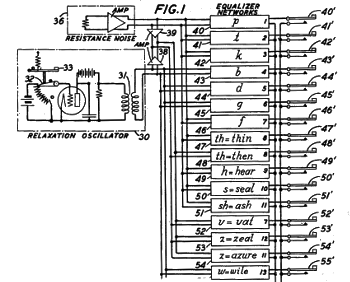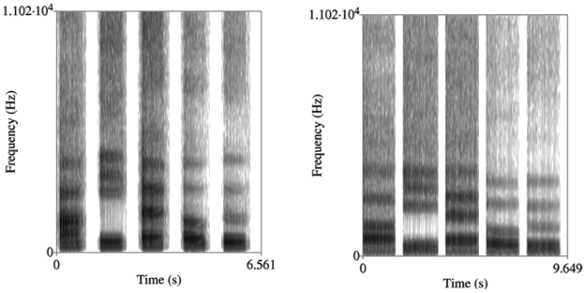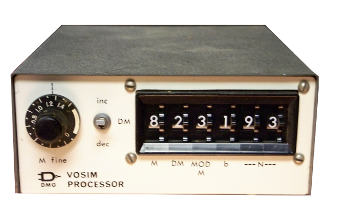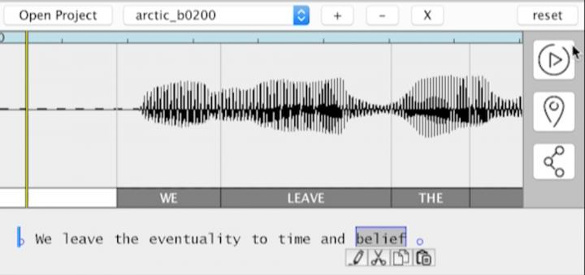Voice Synthesis
June 26, 2017
Two
episodes of
Star Trek: The Original Series, "
The Cage," were a
remix of the unaired
pilot. While there is much memorable content for
science fiction fans in these episodes,
computer scientists would especially enjoy
Spock's simulating Kirk's voice on some primitive looking
mainframe-style computers as part of a
deception to take
command of the
Enterprise.
As I wrote in a
previous article (Computers as Listeners and Speakers, November 4, 2013), the characteristics of the human voice make it amenable to easy
synthesis. First,
speech signals are contained in a limited
audio frequency band below 20
kHz, while
intelligible speech is contained in frequencies between
300-3400 Hz, with most of the amplitude contained between 80-260
Hz.

In older movies, a humorous imitation of the human voice was sometimes done using a slide whistle (shown). The Peanuts movies, based on the Peanuts cartoon of Charles M. Schulz (1922-2000), imitated adult voices using a muted slide trombone.(Wikimedia Commons image by "Ferbr1.")
The limited band for intelligible speech was important to early
telephone system, since
high frequency transmission lines and
components would have been
expensive. Even at that time,
Bell Labs was interested in reducing the transmission cost further, so there was
research in
speech synthesis with the idea that an effective system would allow a lower data rate, data rate in those days before
computers meaning the number of
signal tones.
Bell Labs
acoustical engineer,
Homer Dudley, demonstrated that a crude simulation of human speech was possible even in the days of
vacuum tube electronics by creating a system called the
vocoder.[1-5] Some examples of Vocoded speech can be found on
YouTube.[1]
In the vocoder system, Dudley used a bank of
audio filters to determine the
amplitude of the speech signal in each frequency band. These amplitudes alone were
transmitted to a remote bank of
oscillators to reconstructed the signal. In this manner, the vocoder allowed
compression and
multiplexing of many voice
channels over a single
submarine cable.

Portion of fig. 1 of US Patent No. 2,194,298, "System for the artificial production of vocal or other sounds," by Homer W. Dudley, March 19, 1940.
As the circuit shows, Dudley realized that white noise is an important component of speech.
(Via Google Patents.[4]
It doesn't take too long for a "
person having ordinary skill in the art" to realize that the vocoder data signals could be
transposed to make a
telephone call unintelligible to a
wiretapper. Such
encryption of the speech signal allowed secure voice communications during
World War II.
The vocoder operated on band-limited signals equally spaced over an extended frequency range, but synthesis of human speech requires fewer bands. Human speech is contained in definite frequency bands called
formants which arise from the way that human speech is generated.
Air flow through the
larynx produces an excitation signal that excites
resonances in the
vocal tract, so the signal
amplitude is most prominent at these formant frequencies (see figure).

Spectrograms of the average female (left) and male (right) voicing of vowels. These are the English vowel sounds, 'eh' (bet), 'ee' (see), 'ah' (father), 'oh' (note), and 'oo' as in (boot). Note the overall lower frequencies of the male voice, as well as the slower male cadence. (Fig. 1 of ref. 6, licensed under a Creative Commons License.)[6)]
The development of computers allowed creation of a
speech synthesis technique called
formant synthesis, which is
modeled on the physical production of sound in the
human vocal tract. It was implemented using
linear predictive coding (LPC) in the
source–filter model of speech production.
Texas Instruments created an
LPC integrated circuit that was used in its
Speak & Spell toy.
Today, text to speech is common, and my
e-book reader has a very good
text-to-speech feature with both male and female speakers. However, it does have the tendency to comically render some unusual
character names. Apple's
Siri talking
virtual assistant was introduced in 2011, and it was a featured
plot element in an episode of
The Big Bang Theory (Season 5, episode 14, "
The Beta Test Initiation," January 26, 2012). The
Amazon Echo was introduced in 2015. All of these lagged significantly behind the introduction of the
HAL 9000 in 1997 (according to the film,
2001: A Space Odyssey).
Early analog electronic music synthesizers were capable of making a wide variety of sounds with a limited assortment of
oscillators,
filters, and
amplitude modulators. In 1978,
Werner Kaegi and
Stan Tempelaars of the
University of Utrecht (Utrecht, The Netherlands) developed a simple technique for generating vocal sounds with the limited analog circuitry available at the time.[7] Shortly thereafter, I designed and built an accessory device that implemented their VOSIM technique on analog electronic music synthesizers (see photo).[8]

VOSIM analog electronic music synthesizer (EMS) accessory circuit.
I designed and built this around 1980 for an EMS of my own design.
(Photo by author.)
While speech synthesis has now become common, what isn't common is Spock's type of speech synthesis that I mentioned earlier; that is, synthesizing a specific voice. It would be interesting to have a summary of the daily news read by
Walter Cronkite (1916-2009) and
Edward R. Murrow (1908-1965), or an analysis of
Donald Trump's tweets by
Andy Rooney (1919-2011). Research along these lines is being conducted by computer scientists at
Princeton University and
Adobe Research.[9-11]
The developed
software, named VoCo, can be described as a
word processor for speech, one with the ability to add and modify individual words of a given speaker.[10] The new words are automatically synthesized in the same speaker's voice, and it's not required that these words appear in the original
recording.[10] This technology could eventually allow
information utilities to speak in a more natural voice.[10]
This work, which is scheduled to be presented at the
Association for Computing Machinery SIGGRAPH conference in July, 2017, will be
published in the July issue of the
journal,
Transactions on Graphics.[9] VoCo's
graphical user interface resembles that of other audio editing software, such as
Audacity, the
free-and-open-source software (FOSS) that
Tikalon uses for its audio editing. VoCo includes an additional text
transcript of the
audio track to allow a user to replace or insert new words. VoCo uses the transcript information to automatically synthesize new words by stitching together audio from elsewhere in the audio track.[10]

The VoCo graphical user interface resembles that of a typical audio editor with additional transcript information. (Princeton University image by Adam Finkelstein.)
VoCo functions by searching the audio file of a voice recording and selecting the best possible combinations of
phonemes to synthesize new words in the same voice. There's a lot of computing at play here, since VoCo needs to find the phonemes in the original file, and then smoothly stitch some of them together to create the word. The words are
pronounced with different
intonation depending on the context to create a natural sound.[10] If the synthesized word doesn't sound quite right, there are options for changes.[10]
In a test of the VoCo system, listeners decided that VoCo recording were real recordings more than 60 percent of the time.[10] The
technology behind VoCo can allow creation of a more natural "
robotic" voice for people who have lost their voices, an example being famed
physicist,
Stephen Hawking.[10]
Zeyu Jin, a
graduate student in
Computer Science at Princeton University, relates the following story.
"We were approached by a man who has a neurodegenerative disease and can only speak through a text to speech system controlled by his eyelids... The voice sounds robotic, like the system used by Steven Hawking, but he wants his young daughter to hear his real voice. It might one day be possible to analyze past recordings of him speaking and created an assistive device that speaks in his own voice."[10]
References:
- The Voder - Homer Dudley (Bell Labs) 1939, YouTube video by MonoThyratron, July 9, 2011.
- Homer W Dudley, "System for the artificial production of vocal or other sounds," US Patent No. 2,121,142, June 21, 1938.
- Homer W Dudley, "Signal transmission," US Patent No. 2,151,091, March 21, 1939.
- Homer W. Dudley, "System for the artificial production of vocal or other sounds," US Patent No. 2,194,298, March 19, 1940
- Homer W Dudley, "Production of artificial speech," US Patent No. 2,243,525, May 27, 1941.
- Daniel E. Re, Jillian J. M. O'Connor, Patrick J. Bennett and David R. Feinberg, "Preferences for Very Low and Very High Voice Pitch in Humans," PLoS ONE, vol. 7, no. 3 (March 5, 2012), Article No. e32719, https://doi.org/10.1371/journal.pone.0032719.
- Werner Kaegi and Stan Tempelaars, "VOSIM--A New Sound Synthesis System,"Journal of the Audio Engineering Society, vol. 26, no. 6 (June, 1978), pp. 418-425.
- Devlin M. Gualtieri, "A VOSIM Processor," Electronotes, vol. 13, no. 130 (October, 1981).
- Zeyu Jin, Gautham J. Mysore, Stephen DiVerdi, Jingwan Lu, and Adam Finkelstein. 2017, "VoCo: Text-based Insertion and Replacement in Audio Narration," ACM Trans. Graph., vol. 36, no. 4, Article 96 (To be Published, July, 2017), 13 pages..
- Technology edits voices like text, Princeton University Press Release, May 15, 2017.
- Video Demonstration of the VoCo System at Princeton University Web Site. Also as a YouTube Video, "VoCo: Text-based Insertion and Replacement in Audio Narration," by Adam Finkelstein, May 11, 2017.
Permanent Link to this article
Linked Keywords: Episode; Star Trek; The Original Series; The Cage; remix; television pilot; science fiction; fan; computer scientist; Spock; computer simulation; simulating; James T. Kirk; human voice; mainframe-style computer; deception; command; USS Enterprise, NCC-1701; speech synthesis; speech; signal; audio frequency band; hertz; kHz; intelligibility, communication; intelligible; voice frequency; 300-3400 Hz; Hz; film; movie; humour; humorous; imitation; slide whistle; Peanuts movie; Peanuts; Charles M. Schulz (1922-2000); mute (music); muted; slide trombone; Wikimedia Commons; telephony; telephone system; high frequency; transmission line; electronic component; expense; expensive; Bell Labs; research; computer; signal tone; acoustical engineering; acoustical engineer; Homer Dudley; vacuum tube; electronics; vocoder; YouTube; audio filter; amplitude; transmission, telecommunications; transmitted; electronic oscillator; data compression; multiplexing; channel, communications; submarine communications cable; Google Patents; person having ordinary skill in the art; transposition cipher; transpose; telephone call; telephone tapping; wiretapper; encryption; World War II; formant; air flow; larynx; resonance; vocal tract; amplitude; spectrogram; average; female; male; vowel; English language; cadence; Creative Commons License; formant synthesis; physical modelling synthesis; human vocal tract; linear predictive coding; source–filter model of speech production; Texas Instruments; LPC integrated circuit; Speak & Spell toy; e-book reader; text-to-speech; character; Siri; virtual assistant (artificial intelligence); plot element; The Big Bang Theory; The Beta Test Initiation; Amazon Echo; HAL 9000; 2001: A Space Odyssey; early analog electronic music synthesizers; amplitude modulation; amplitude modulator; Werner Kaegi; Institute of Sonology; Stan Tempelaars; University of Utrecht (Utrecht, The Netherlands); Walter Cronkite (1916-2009); Edward R. Murrow (1908-1965); Donald Trump; Twitter; tweet; Andy Rooney (1919-2011); Princeton University; Adobe Research; software; word processor; digital recording; information; Association for Computing Machinery; SIGGRAPH conference; scientific literature; published; scientific journal; ACM Transactions on Graphics; graphical user interface; Audacity; free-and-open-source software; Tikalon; transcript; audio track; Adam Finkelstein; phoneme; pronunciation; pronounce; intonation; technology; robot; robotic; physicist; Stephen Hawking; Zeyu Jin; postgraduate education; graduate student; Computer Science at Princeton University; neurodegeneration; neurodegenerative disease; eyelid; daughter; Homer W Dudley, "System for the artificial production of vocal or other sounds," US Patent No. 2,121,142, June 21, 1938; Homer W Dudley, "Signal transmission," US Patent No. 2,151,091, March 21, 1939; Homer W. Dudley, "System for the artificial production of vocal or other sounds," US Patent No. 2,194,298, March 19, 1940; Homer W Dudley, "Production of artificial speech," US Patent No. 2,243,525, May 27, 1941.